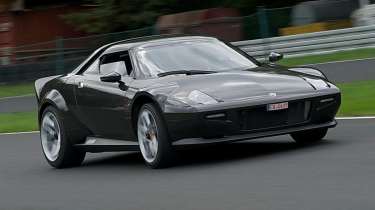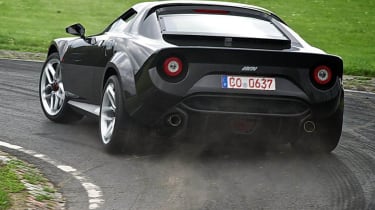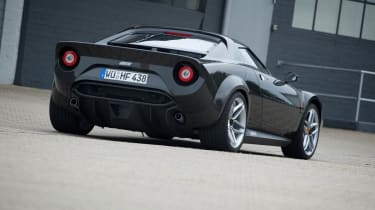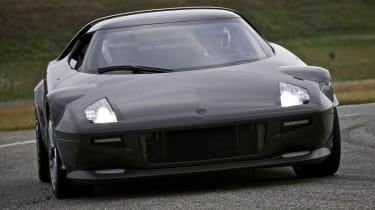New Lancia Stratos supercar review
John Barker was the first journalist in the world to drive the Ferrari 430 Scuderia-based New Stratos in 2010. He came away very impressed
It really is purely by chance that I’m first into the quite exquisite recreation of the Lancia Stratos HF. Had there been a journalist here called Vince Aardvark, he could have claimed the honour because the schedule of drives has been determined alphabetically. To the other members of the press who have come from as far as Japan this might look like a fix because the first three in the car – Barker, Barlow and Bremner – are all from the UK.
This is no big manufacturer launch, but you’d hardly know it. ‘New Stratos’ is described as a non-commercial project but it is being presented to selected press with panache and imagination. We landed at Le Castellet airport alongside Circuit Paul Ricard in a small, chartered plane not 15 minutes ago and made our way to a semi-opaque rotunda erected on the infield at one end of the strung-out track. As we approached, there were tantalising glimpses of colours and shapes that would excite any Stratos fan, and then we’d ducked into its warmth, the air pulsing with chill-out tunes, to be greeted by a fabulous display of four significant Stratoses (Stratii?).Ranged from right to left were the fluorescent red Bertone road car prototype, an utterly original, lime green production car, an immaculate, Marlboro-liveried Group 4 rally car, and the Fenomenon concept car from the 2005 Geneva motor show.
What is it?
The chunky Fenomenon ‘on-road, off-road supercar’ is the key car here, the link between the old and the new. It was the brainchild of Chris Hrabalek, serial Stratos collector and RCA-trained car designer, and five years ago it woke the world up to the idea of a modern Stratos. Hrabalek sought investors to create the Fenomenon and among the ten who bought into the concept and the Stratos brand was Michael Stoschek, chairman of Brose, a giant German automotive parts company. Although the Fenomenon never progressed, when Stoschek retired from the day-to-day running of Brose in 2005 after 34 years, Hrabalek persuaded the businessman and race driver that creating a new Stratos was a brilliant idea!
More reviews
Group tests
- Alpine A290 v Alpine A110 – how much DNA do they really share?
- Ariel Atom 4R v Caterham Seven ‘evo25’: power-to-weight heroes go head-to-head
- Caterham Super Seven 600 v Super Seven 2000
- Levante v T1
- Corvette Stingray v Porsche Cayman GTS v Audi R8 RWD
- Great Ferrari hypercars driven: 288 GTO, F40, F50 and Enzo head-to-head
- Hardcore Ferrari V8 specials go head-to-head
- Lamborghini Aventador Ultimae v Lamborghini Countach
- Lotus Emira v Morgan Plus Four – four-cylinder Brits go head-to-head
- Toyota GR86 v BBR Mazda MX-5: supercharged drop-top battles sports coupe
In-depth reviews
- Abarth 600e 2025 review – Italy gives the Alpine A290 something to worry about
- Alpine A110 review – distinctive, lightweight and unforgettable to drive
- Audi R8 (2015 - 2024) review – the ultimate soft-focus supercar
- Bentley Continental R Mulliner: review, history and specs
- BMW 5-series review – is this still Munich’s anchor model?
- BMW 1-series review – Munich’s Audi A3 rival gains focus
Long term tests
- Abarth 695C Turismo Fast Fleet test – 10,000 miles in the Italian hot hatch
- Alfa Romeo Giulia Veloce Fast Fleet test – 7000 miles in the sharp Italian saloon
- Alpina B10: end of term report
- Alpina B10
- Ford Mustang GT
- Ford Mustang GT
- Ford Mustang GT
- Land Rover Defender 110 Fast Fleet test – 9000 miles in the go-anywhere SUV
- Maserati Ghibli Trofeo Fast Fleet test – 4000 miles in the Ferrari-powered saloon
- Mitsubishi Evo MR 340
Review
- New Aston Martin DBS 770 Ultimate review – 759bhp super-GT driven
- New Bentley Batur 2023 review – can it possibly be worth £1.65m?
- 2023 Chevrolet Corvette C8 Z06 review – the American 911 GT3?
- Kia EV6 GT-Line S prototype review – the EV that shows how it’s done
- BBR Supercharged Mazda MX-5 (ND) 2023 review – tuned 250bhp roadster driven
- MG4 Trophy 2023 review
Reviews
- Abarth 695 75 Anniversario edition 2024 review – a fitting send-off for Abarth’s hot supermini?
- Abarth 500e 2023 review
- AC Cobra 378 Superblower MkIV 2021 review – another V8 Cobra, but with a GM heart this time
- Acura Integra Type S 2024 review – a Honda Civic Type R with added restraint
- Alfa Romeo Giulia 2025 review – get one while you still can
- Alfa Romeo SZ: history, review and specs of an icon
- Alfa Romeo 1750 TBi
- Alpina B3 GT Touring 2025 review – a 190mph alternative to the BMW M3 Touring
> Anatomy of a Group B rally car
They approached a number of small-volume car makers including Koenigsegg, Gumpert, Prodrive and Ruf to see if they would be interested in building it. Then the pair saw the Ferrari P4/5 created by Pininfarina on the Enzo platform for James Glickenhaus and they knew they’d found their company. The one-of-a-kind homage to the classic Ferrari 330 P3/4 demonstrated all the skills that would be needed to create the new Stratos, which it had been decided should be based on the Ferrari 430 Scuderia. In September 2008, Pininfarina and Stoschek agreed terms. Just over two years later, it is ready.
After welcomes and introductions, a stirring compilation of the original Stratos’s competition exploits is played on the big screens, the rock ‘n’ roll soundtrack enhanced by the raspy, buzz-saw growl of the Dino V6 swinging the rump of the tiny, mid-engined wedge as it powers along, here on fat asphalt tyres, there on spindly snow tyres, here with bull bars and Alitalia livery, there in Pirelli black and red with a Carello lightpod. Then, with the audience sufficiently roused by the footage, the sound is augmented by the more urgent cry of another Ferrari engine, this one real and fast approaching. In a flurry of downshifts the noise homes right in and then there it is, the new Stratos, driving into the rotunda right in front of us.
Technical highlights?
Wow! What a thing; what a sculpture. It’s Stratos, pure and simple, but on a slightly larger scale, an idea we’ve got used to with remakes of the Mini, Beetle, Camaro and others. Initially I thought it was rather under-played in sober grey-black but closer inspection reveals that beneath the lacquer is a carbonfibre weave that looks very cool indeed.
The shape is bang-on but what marks this out as a top-drawer professional job is the detailing. I adore the way the roof spoiler, which sits up like a supermarket basket handle on the original, is blended into the rear clamshell at its base so that it’s a spoiler on its top edge but forms engine air intakes down its sides. Then there are the rear lights: on the original they are mounted on moulded plastic cups but on the new one the lights (borrowed from the 599) are mounted on mesh grilles. The grilles work as vents too, extracting engine-bay heat, according to Luca Borgogna, Pininfarina’s main designer on the project.
Anoraks like us would probably guess from the hollow howl and slightly plain idle that the heat to be extracted is generated by a flat-plane crank Ferrari V8, and a glance through the engine cover confirms this. In fact, a whole 430 Scuderia has been sacrificed to make the new Stratos, and surprisingly little of it remains. The team at Pininfarina took measurements and tested the Ferrari’s aerodynamics to see where they were starting from, and then peeled away the Scuderia’s aluminium bodywork to reveal its extruded aluminium sub-structure.
To get the correct, much squarer wheelbase- to-width ratio of the original Stratos, they cut the Scuderia chassis in half just ahead of the rear bulkhead, lopped out a 200mm section, and welded it back together. From that base, they worked on getting the correct proportions for the compact cockpit with its distinctive, visor-like windscreen, and once that was set, everything else flowed from it. The screen pillars sit a full 250mm further inboard than those of the Ferrari and the cockpit frame is formed from FIA-spec, 40mm diameter steel tubing, which adds significant structural rigidity.
> Click here for our Audi RS5 review
The design process was very much like that of a production car, with mock-ups of styling proposals and computer-aided design helping with the packaging, some of which was very tight. There was wind tunnel testing, too, to perfect the shape of the front splitter, side sills and roof spoiler. Borgogno was afraid that the ducktail would act like an air brake, but in fact the roof spoiler neutralises its effect and it was quite easy to make the car aerodynamically balanced at speed.
If there’s one controversial aspect it’s the headlamps. Pop-ups are a no-no these days, so they had to be faired-in and it’s the angle of their top edge that upsets most people. To some eyes, they make the Stratos look sad. But Stoschek was insistent that this was how they would be. And Mr Stoschek gets what he wants; at his insistence the shots of the car testing at Balocco, Fiat’s proving ground, have not been re-touched; it is what it is. My suspicion is that that is partly why we, the selected world’s motoring press, have been invited here to drive the finished item; he wants our opinion, straight and unfiltered. He’s already had the opinion of Ferrari president Luca di Montezemolo who drove (and signed) the car at Fiorano.
What’s it like to drive?
The late arrival of our snow-delayed flight means that the schedule has been squeezed and just a few minutes after the car appears, my name is called and I’m ushered into the passenger seat alongside Maximilian Stoschek. Sit in an original Stratos and it’s so narrow you can reach out and touch the base of the far screen pillar, while you rub shoulders with the driver and your feet are pushed slightly to the centre of the car by the intrusion of the front wheelarches. Not here. There’s plenty of room and although there are some obvious Ferrari elements – steering wheel, centre console, heater switches – the car feels and looks quite different with its deep, wrap-around screen and sizeable, square instrument binnacle.
The instruments are wonderfully evocative, set into the brushed aluminium panel echoing the original Stratos layout and with period markings. They are the Ferrari dials, simply separated, re-faced and repositioned, with two extra dials, a clock and a G-meter, to make the numbers up to the required Stratos count. Neat.
I strap myself into the lightweight bucket with the multi-point race harness, the door slams shut, Max tugs the right-hand paddle and we’re off. Now, this is a race track and therefore very smooth, yet the first thing that strikes me is how supple the ride is. I wasn’t expecting that.
The only parts of the original suspension that remain are the wishbones. Even the bushes have been replaced with firmer mounts for greater precision and the electronic Sachs dampers have been recalibrated by the same engineers who worked on the Scuderia set-up. We tack into the first turn, a sharp-ish right-hander, and there’s a real sense of the short wheelbase – the car feels so alert, so keen to change direction. Almost immediately we’re into a longer, looping left. I get a strong sensation of mass muscling along just behind and I think ‘Stratos’. Blimey, 30 years after the original, a new version comes along and it doesn’t just look like the old one, it feels like it too!
What it doesn’t feel is very fast. Maybe Max is soft-pedalling a little, fighting shy of using all the revs or being too aggressive with the throttle, this being the one and only and me being the first of many to want to experience it, but I was expecting a bit more of a kick. Especially as the V8 has been fitted with a Capristo high-performance exhaust system reckoned to help liberate an extra 20bhp for a healthy 523bhp, and because it has less mass to haul, too: new Stratos is 470mm longer than the original but 330mm shorter than the Scuderia and at 1270kg it weighs a significant 80kg less than the donor car too.
The weight of every component, down to the last nut, bolt and washer, has been reduced as far as possible, an approach that has challenged the engineers of Stoschek’s own company. An unusual feature of the original Stratos that showed it was one of the first cars designed specifically for rallying was a door-bin on each side large enough to take a crash helmet. The new Stratos has them too, though rather than the simple, tilting side windows of the original, Brose engineered exceptionally lightweight electrically operated windows.
> Renault 5 Turbo: birth of an icon
The lack of inertia in the car can certainly be felt in the way it changes tack but less so in a straight-line. Or so it seems until Max pulls back in and we swap seats. A couple of laps in, I realise that the Stratos is going much faster than it appears when I notice that the ‘pace car’ that’s leading me, a current 911 Carrera 2, is working its tyres really hard. It’s like when you see the Merc SLS pace car being driven tidily to its limit by Bernd Maylander and then see the shocking contrast when the camera shot changes to the Formula 1 cars that are just loafing along behind.
Initial observations are that the steering wheel feels quite big (it’s the Scuderia’s but with a flat-bottom), that the long, carbonfibre gearshift paddles from the 430 racer feel flimsy and that the car feels solidly engineered. And the power is there all right, viciously, vocally, when you get the revs up and all the tell-tale lights embedded into the top of the steering wheel illuminate at 8500rpm. It’s a very communicative car: through the electrically- assisted power steering you can feel the front coming under pressure as you peel into turns with enthusiasm, and when you get on the gas you can sense the mass behind becoming energized, becoming charged with potential. Snap the throttle closed mid-corner and it might just pirouette seems to be the message. Very Stratos.
However, as the Carrera 2 shows, on this flat, relatively featureless track, you’re pushing harder than you might imagine. And besides, you’re safe from a spin unless you’ve twisted the manettino all the way to the right. Yes, the Scuderia’s adaptive systems are still in place, mostly. The significant element missing is the E-diff, replaced by a Drexler limited- slip diff that saves 20kg, but both the damper stiffness and gearshift speed are changed as the progressively racier settings are selected. There’s anti-lock, too, for the Scuderia’s ceramic brakes, which illustrates how thoroughly engineered the Stratos is.
To be honest, I hadn’t even noticed that the manettino was there, and even if I had, I doubt that Max would have let me go near it. At the end of my all-too-brief five laps, I clamber out and ponder the experience. It’s probably most like a 911, in that you have to manage the front end to be able to get the power on and use the mass over the rear.
Tiago Monteira, ex-F1 and current WTCC driver, has helped with development, which included bench-marking against the Scuderia and current 911 GT3 RS. ‘Because of the short wheelbase you can change from understeer to oversteer in a snap second,’ he says, but adds that the car is very adjustable, very open to suggestion: ‘You can do ten laps and have ten different experiences at the same corner.’ It all depends on your approach, he says, adding that it’s very easy to control and that the different settings on the manettino offer distinct changes in feel. He also says it makes the Scuderia feel heavy and less responsive by comparison.
The rumour is that the car has cost around £3million to make, and before we leave, Michael Stoschek announces that there could be a limited run of 25 cars. Each might cost half a million pounds, including the donor car, but the price will depend on the exact number of the run, he says.
I don’t think they will have much trouble finding that many enthusiasts. It is an astoundingly well made and beautifully engineered homage to the Stratos that brings the concept bang up to date. It would hardly matter if it wasn’t a great drive but, fittingly, it feels challenging in exactly the same way that the original is, offering up all the agility you can handle but with modern safety systems if you’re not up for it. It’s a credit to all those involved. The Stratos lives, and how.
| Engine | 4308cc, V8 |
| Max power | 532bhp @ N/Arpm |
| Max torque | 347lb ft @ 5250rpm |
| 0-60 | sub-4sec (est) |
| Top speed | 195mph+ (est) |
| On sale | Fingers crossed... |






